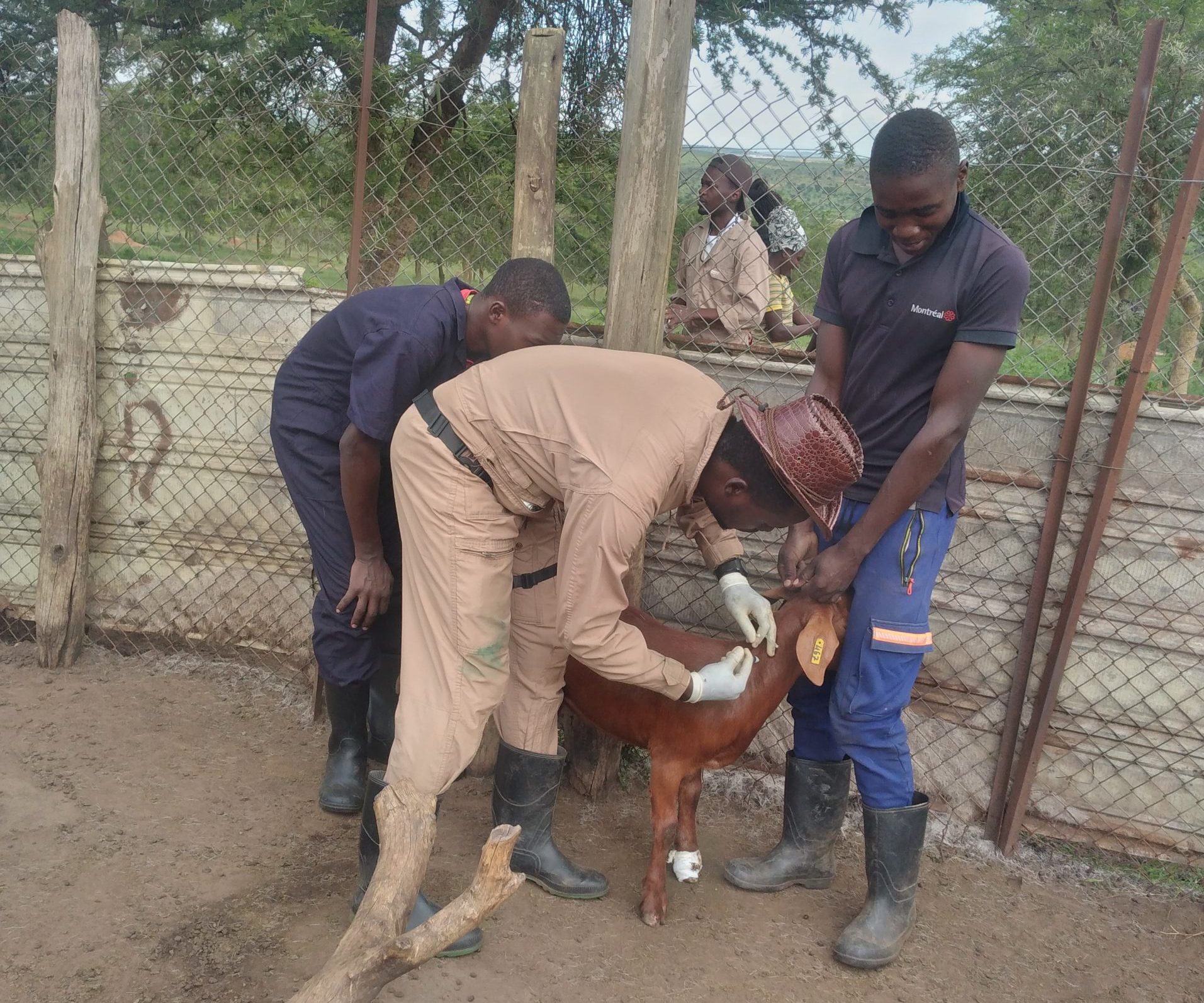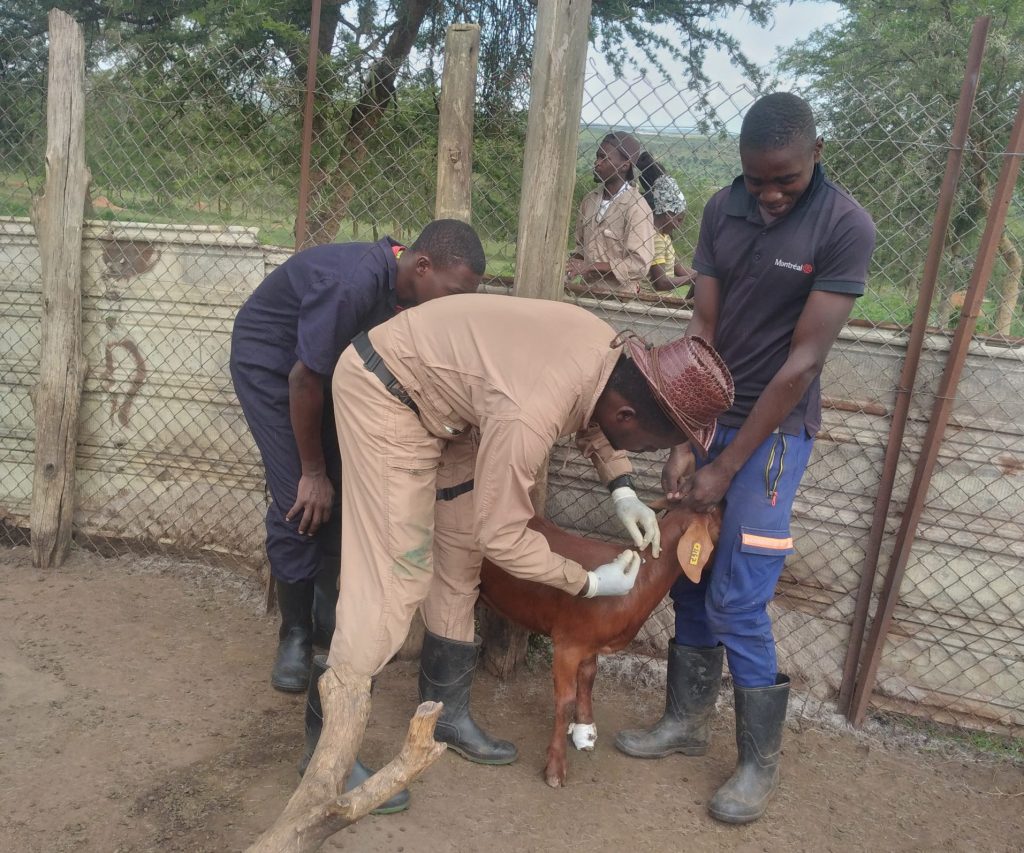Worm infestation in goats
Helminthiasis, also known as worm infestation, is a common problem among goats, especially those kept in confined settings such as domestic or commercial herds. Goats are prune to various types of helminth infestations, the most common being nematodes (roundworms), cestodes (tapeworms), and trematodes (flukes). Goats and cows are naturally susceptible to helminths, as they graze on infected pastures and consume contaminated water. This can lead to the ingestion of larvae or eggs of parasitic worms. These parasites affect the overall health, productivity and reproductive performance of the goats, and if left untreated, can lead to significant economic losses for the owner. Common symptoms of helminthiasis include anemia, poor growth rate, weight loss, low appetite, pot belly, dull coat, diarrhea, lethargy, death.

Goats in their collecting yard waiting to be released to go and graze.
Nematodes (round worms )
Nematodes are the most widely distributed and damaging parasites found in goats, particularly in tropical and subtropical regions. They are a significant health concern for goats especially in warm and moist environments. The common nematodes include Haemonchus contortus (barber pole worm), Trichostrongylus spp (small stomach worm), Trichuris spp (Whipworm), Cooperia spp , Oesophagostomum columbianum, etc.
Haemonchus contortus; this worm is particularly damaging to young goats and can cause severe anemia leading to death if left untreated. The female worm lays its eggs in the goats’ stomach, the larvae attach themselves to the lining of the digestive system, feeding on blood. This can lead to the loss of red blood cells, causing anemia.
Trichostrongylus ssp; This worm affects goats of all ages. The symptoms of the small stomach worm infestation include diarrhea, weight loss and decreased milk yield.
Trichuris spp; this worm lives in the large intestines’ of the goat. The adult worms lay their eggs which are then passed in the goats feaces, contaminating the pasture. The goats become infected by ingesting the eggs while grazing.
Goat farmers must take specific measures to control and prevent nematodes in their herds. The first step is to ensure that pastures are properly managed. Overgrazing can lead to pasture contamination facilitating the spread of worms. Properly rotating pastures, allowing pastures to rest using alternative grazing methods like strip grazing and avoiding overcrowding can help reduce the risk of nematode infestations.
Cestodes the Tape worms.
Cestodes are another type of helminth that can infect goats. They are also called tape worms, they are parasitic worms that can cause significant harm to goats. These worms can infest the small intestines, thoracic cavity and brain of goats. They cause a variety of symptoms.
Cestodes have a complex lifecycle which starts when eggs are passed in the feaces of an infected animal. These eggs are then ingested by an intermediate hosts ( arthropod or a veterbrate ) which can be grazing on pasture or other sources of vegetation. The cysticercoids larvae develop in the intermediate host and are ingested by the final host when they consume the flesh of the intermediate host. Once inside the final host, cysticercoids become adult tape worms and attach themselves to the intestinal wall of the goat with hooks and suckers. There are several species of cestodes that can infect goats including Moniezia expansa and Moniezia benedeni. These species are the most common tape worms found in goats and can cause significant harm if left untreated. Others include echinococcus species (hydatid worm) . In some case tape worm infestation can lead to severe digestive problems and even death
The best way to prevent cestode infestation in goats is to maintain strict parasite control measures. This includes regular deworming and maintaining a clean and hygienic environment for goats. It is also essential to provide good nutrition and avoid overcrowding to keep the goats healthy and strong.
Trematodes the Flat worms.
Trematodes, also called fluke worms. They cause severe illness and even death in goats. Trematodes have a complex life cycle that involves different hosts which makes controlling and reducing their impact challenging. Trematodes have a direct lifecycle where the adult worms live and lay eggs in the host’s intestines. The eggs are passed out in the feaces and develop into larvae known as miracidium when they come into contact with water. The miracidium enters the snail where it develops into sporocyst stage. The resulting cercaria are then released into the environment, infecting grazing animals like goats when they ingest the cercaria contaminated water. In the goat’s intestine, the cercaria develops into adult flukes, and the cycle continues.
The most common trematode species found in the goats are the Fasciola hepatica and Fasciola gigantica (liver flukes), Paramphistomum species ( gastrointestinal worms ). These flukes cause damage to the internal orgarns leading to weight loss, anemia, diarrhea and death. Hence, it is crucial to take preventive measures such as deworming and avoiding contamination of water sources. Grazing animals can prevent contamination by implementing rotation grazing, providing clean water sources and fencing off wet areas. Farmers should also avoid over crowding to ensure proper sanitation practices.
Prevention and Control of Helminthiasis in Goats and Cows.

goat being dewormed using an injectable dewormer
The best way to prevent the spread of helminthiasis in goats and cows is by implementing proper hygiene practices on the farm. This includes regular cleaning of animal housing structures, offering clean water and feeds, and providing regular veterinary check-ups for the animals.
Another effective strategy for controlling helminthiasis is rotational grazing. This involves moving livestock between pastures to reduce the level of contamination in the soil. This helps to reduce the exposure of animals to helminths leading to reduced incidence.
Veterinary professionals recommend deworming programs as part of helminthiasis prevention strategies. These programs involve the use of anthelmintic drugs that kill or eliminate the parasites from the animals. However, veterinary guidance is crucial as, mismanaged deworming programs may lead to drug resistance or drug adverse reaction. Request an Appointment
In conclusion; farmers should monitor their goats regularly, looking out for signs of infection. Worms are a significant health threats to goats and their infestation can lead to significant economic losses. The prevention and control of worm infestation requires a combination of strategies. it is therefore essential to consult with a veterinary practitioner ( Home ) for appropriate and effective treatment options. Regular veterinary checkups and consultations are recommended.

